Chinese pond heron
| Chinese pond heron | |
|---|---|
 | |
| Adult in breeding plumage | |
 | |
| Adult in winter plumage | |
| Scientific classification | |
| Kingdom: | Animalia |
| Phylum: | Chordata |
| Class: | Aves |
| Order: | Pelecaniformes |
| Family: | Ardeidae |
| Genus: | Ardeola |
| Species: | A. bacchus |
| Binomial name | |
| Ardeola bacchus (Bonaparte, 1855) | |
 | |
| Global range of A. bacchus, compared to its presumed closest relatives Ardeola bacchus Breeding range Ardeola bacchus Non-breeding range Ardeola grayii range Ardeola speciosa range | |
The Chinese pond heron (Ardeola bacchus) is an East Asian freshwater bird of the heron family, (Ardeidae).

It is one of six species of birds known as "pond herons" (genus Ardeola). It is parapatric (or nearly so) with the Indian pond heron (A. grayii) to the west and the Javan pond heron (A. speciosa) to the south, and these three are presumed to form a superspecies. As a group they are variously affiliated with the squacco heron (A. ralloides) or the Malagasy pond heron (A. idae). As of mid-2011 there are no published molecular analyses of pond heron interrelationships[2] and osteological data is likewise not analyzed for all relevant comparison taxa.[3]
Description and ecology
The Chinese pond heron is typically 47 cm (19 in) long with white wings, a yellow bill with a black tip, yellow eyes and legs. Its overall colour is red, blue and white during breeding season, and greyish-brown and flecked with white at other times.[4]
It is found in shallow fresh and salt water wetlands and ponds in China and adjacent temperate and subtropical East Asia. Essentially a lowland bird, its range is delimited by the subarctic regions in the north, and by the mountain ranges in the west and south.[4]
The species is prone to some vagrancy. One individual in breeding plumage was seen by the river at Bonzon near Gangaw – just inside the Chin State of Burma – west of the species' usual range, on April 8, 1995. A stray bird stopping over on Saint Paul Island, Alaska on August 4–9, 1997 was the first recorded occurrence of this species in the United States.[5][6]
Its food consists of insects, fish, and crustaceans. The Chinese pond heron often nests in mixed-species heronries. It lays a clutch of 3–6 blue-green eggs.[4]
It is fairly common and not considered a threatened species by the IUCN.[7]
References
- ↑ BirdLife International (2012). "Ardeola bacchus". IUCN Red List of Threatened Species. Version 2013.2. International Union for Conservation of Nature. Retrieved 26 November 2013.
- ↑ Though a number of studies have used DNA of A. bacchus, there is almost no comparison data from other Ardeola: GenBank: Ardeola bacchus, Ardeola. Retrieved 2011-JUL-14.
- ↑ McCracken, Kevin G.; Sheldon, Frederick H. (1998). "Molecular and osteological heron phylogenies: sources of incongruence" (PDF). Auk. 115: 127–141. doi:10.2307/4089118.
- 1 2 3 Robson, Craig R. (2002). A guide to the birds of Southeast Asia: Thailand, Peninsular Malaysia, Singapore, Myanmar, Laos, Vietnam, Cambodia. New Holland, London. ISBN 1-85368-313-2
- ↑ Robson, Craig R.; Buck, H.; Farrow, D.S.; Fisher, T.; King, B.F. (1998). "A birdwatching visit to the Chin Hills, West Burma (Myanmar), with notes from nearby areas" (PDF). Forktail. 13: 109–120.
- ↑ American Ornithologists' Union (2000). "Forty-second supplement to the American Ornithologists' Union Check-list of North American Birds" (PDF). The Auk. 117 (3): 847. doi:10.1642/0004-8038(2000)117[0847:FSSTTA]2.0.CO;2.
- ↑ BirdLife International (2012). Ardeola bacchus. In: IUCN 2012. IUCN Red List of Threatened Species. Version 2012.2.
External links
 Media related to Ardeola bacchus at Wikimedia Commons
Media related to Ardeola bacchus at Wikimedia Commons Data related to Ardeola bacchus at Wikispecies
Data related to Ardeola bacchus at Wikispecies- "Chinese pond heron media". Internet Bird Collection.
- Chinese pond heron photo gallery at VIREO (Drexel University)
